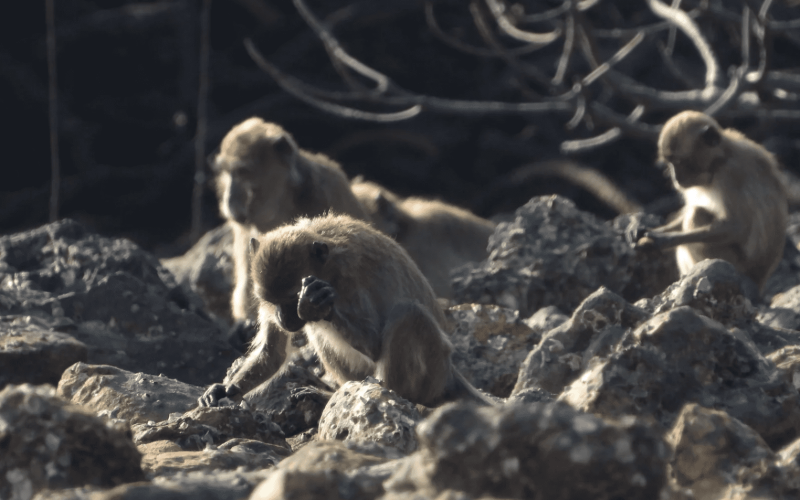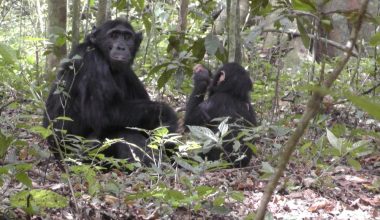Researchers, including those from the Max Planck Institute for Evolutionary Anthropology, analyzed stone tools used by long-tailed macaques in a national park in Thailand and found them to be similar to early human ancestor tools. They found fragments from these tools bear the same characteristics commonly used to identify intentionally made stone tools by early human hominin ancestors.
In Thailand, monkeys frequently unintentionally produce sharp flakes of rock that resemble the stone cutting tools used by early humans when they use stones as hammers and anvils to aid them in cracking open nuts.
Archaeologists are pondering if they should revise their presumptions on some of the stone artifacts made by early human ancestors more than a million years ago in light of this unexpected discovery, which was reported in the journal Science Advances.
“You have a bunch of nonhuman primates that are creating objects that look a lot like the kinds of things that we have wanted to exclusively attribute to the behavior of humans and human ancestors,” says Jessica Thompson, a paleoanthropologist at Yale University who wasn’t on the team that conducted this new research.
She notes that the manufacture of sharp cutting tools made of stone, which could date as far back as 3.3 million years ago, has long been seen as a key technological innovation in human history, one that’s wrapped up in a host of assumptions about the evolution of uniquely human traits.
But now, says Thompson, archaeologists will have to grapple with the problem of trying to figure out whether sharp stone flakes were made intentionally or accidentally. “It has repercussions that range from, like, when did people start to go into South America up to, like, when did people make the first ever stone tools,” she explains.

Scientists formerly believed that producing and using tools was solely a human activity, but they now realize that animal usage of tools is actually quite frequent Nonetheless, it is quite uncommon for primates to use stone tools.
A small number of chimpanzees in West Africa are known to use rocks as hammerstones, although they don’t leave many flakes behind, perhaps because of the type of stone they use. And Capuchin monkeys in Brazil have been shown to pound seeds and nuts with stones — something they’ve apparently done for hundreds of years, leaving behind their own archaeological record. That’s why some researchers have recently called into question some of the earliest evidence in Brazil for when humans might have entered the continent, saying ancient sites from 50,000 years ago could have been created by monkeys instead of people.
The Capuchin monkeys also sometimes deliberately break rocks by pounding them together for unknown reasons (they also sometimes lick or sniff the crushed stone). This activity produces accumulations of sharp-edged flakes that can look like intentionally-made stone tools — even though those monkeys in Brazil never use the broken flakes as a tool, scientists reported in 2016.
Some of the researchers involved in that study have now turned their attention to wild, long-tailed macaques in Thailand. These monkeys routinely use stones as anvils and hammers to crack open the nuts of oil palms.
“They’re a little bit bigger than peanuts, and they can be quite hard,” says Tomos Proffitt, with the Max Planck Institute for Evolutionary Anthropology. “They put the oil palm nut on the anvil and use a hammerstone in one or both hands.”

As the monkeys repeatedly try to whack the nut, they sometimes miss and instead hit the two stones together. This creates broken pieces of stone that collect around the anvil.
“These tools and these broken pieces looked really similar to some of the things that we would see in the early archaeological record,” says Proffitt.
David Braun, an archaeologist with George Washington University, says it was actually “somewhat disturbing” for him to walk into the forest and see hundreds of artifacts littering the ground, “and to know that there are no humans doing this.” If archaeologists like him came across these tools in an excavation from a million years ago, he says, “we would have diagnosed this as, ‘Oh, they are making flakes to cut up things.’ But they’re not.”
No one has seen these monkeys do anything with the flakes — apparently, they have nothing they want to cut. “As soon as a flake falls on the floor, it just stays there,” says Proffitt. He and his colleagues have analyzed over a thousand stone pieces associated with the monkeys, which they call “the most extensive dataset of nonhuman primate percussive flakes and flaked stones to date.”
When they compared these stones with collections of stone artifacts, or assemblages, from ancient human ancestral sites in Tanzania, Kenya, and Ethiopia, they found a lot of similarities and overlaps. There are ways to distinguish stone tools specifically made for cutting, like the presence of animal bones with cut marks, additional modifications to make the tools fancier, or evidence that stone was imported from another location specifically for the purpose of making tools.
Also, archaeologists can look at the core piece of rock that was hit to produce flakes, to see if there are patterns suggesting the toolmaker understood fracture patterns and was exploiting them.
Nonetheless, Braun says a person could throw “quite a number” of macaque-produced flakes into an excavation of early human artifacts and no one would notice. “Are the assemblages we see in the fossil record made by monkeys? Probably not,” says Braun.
But he thinks archaeologists now have to seriously consider that some or even a lot of the sharp flakes they see at human sites could have been made unintentionally.
“It is quite possible that some of the records that we assume to be associated with producing sharp edges could actually be a percussive technology,” he says. In particular, Thompson thinks this study could add to the debate over the nature of one archaeological site in Kenya that dates back to 3.3 million years ago. That site has what looks like very primitive stone tools that would be the oldest ever found. They’re so old that they would have been made by a more ancient species than the earliest humans in the Homo genus.
Emma Finestone, a stone tool expert at the Cleveland Museum of Natural History, says this new research is interesting to keep in mind when thinking about the first use of stone tools in human history. “Could it have started as percussive behaviors being more prominent, and then the flakes came along as a byproduct of percussion?” she says. “Maybe that’s a clue for how stone tools began in the first place.”
Chimpanzees and other primates with sharp canines don’t need knives because they can rip open almost anything they want with their teeth, says Braun. While wild primates haven’t been observed using cutting tools, captive primates can be trained to do so, and one untrained orangutan in captivity was observed to spontaneously use a sharp stone to cut something.
Over the course of human evolution, teeth shrink in size as brain size increases, says Braun, and sharp cutting tools became a necessity if humans were going to exploit large game as a food resource.
Source: npr.org






